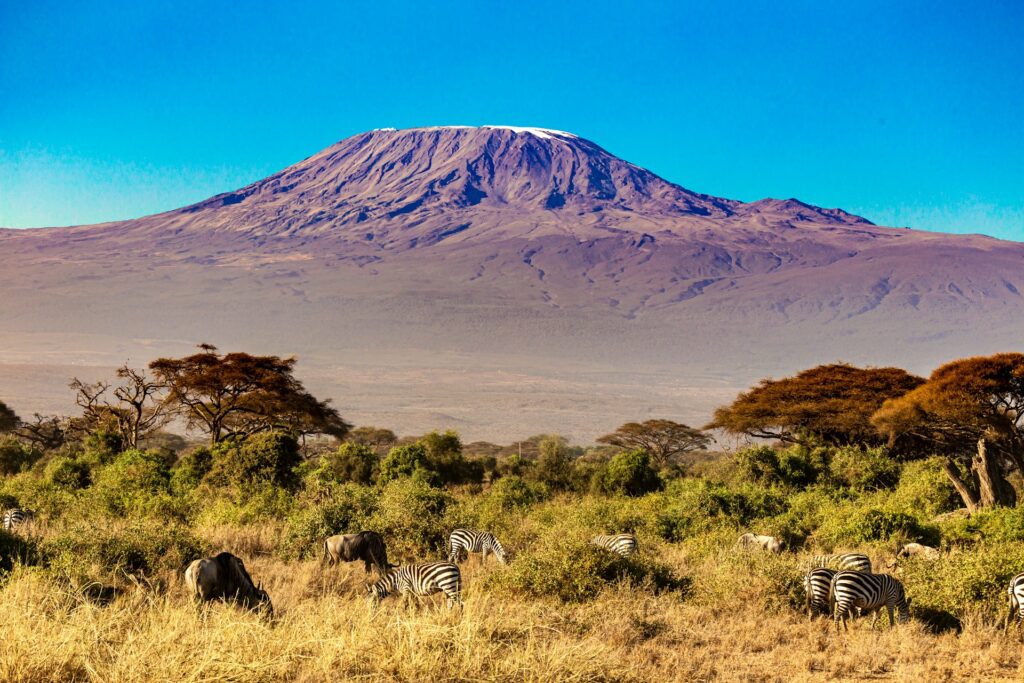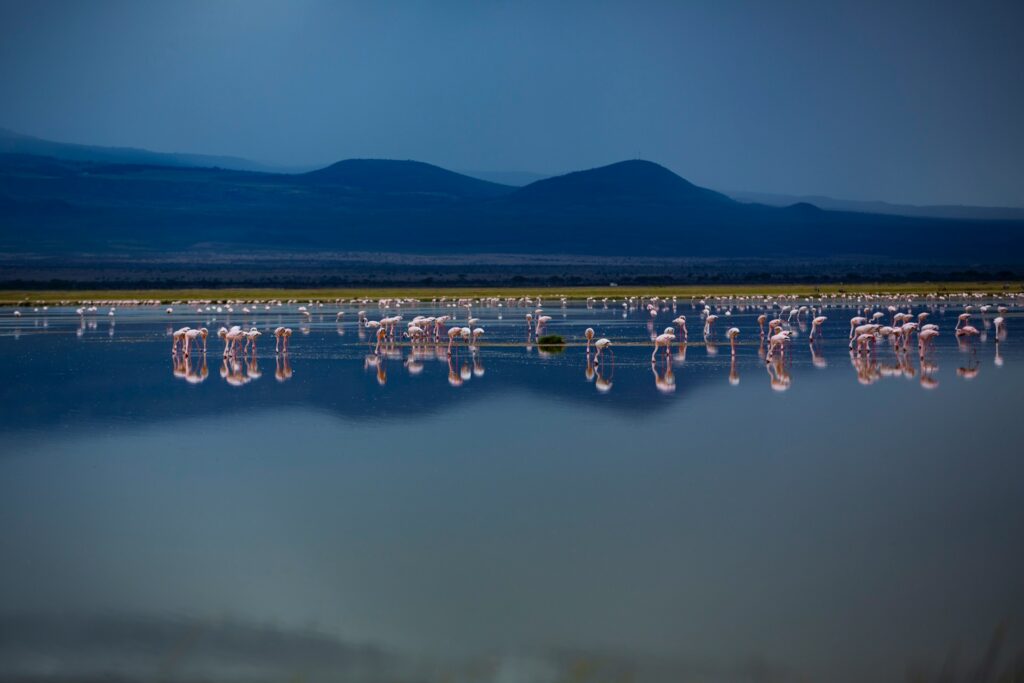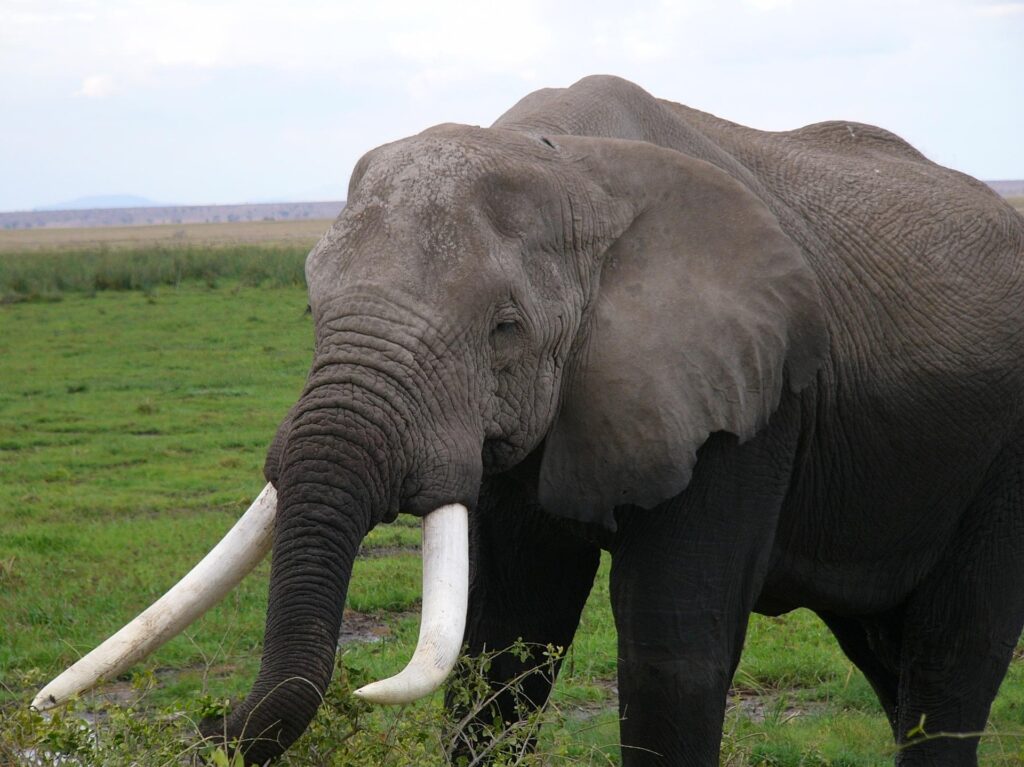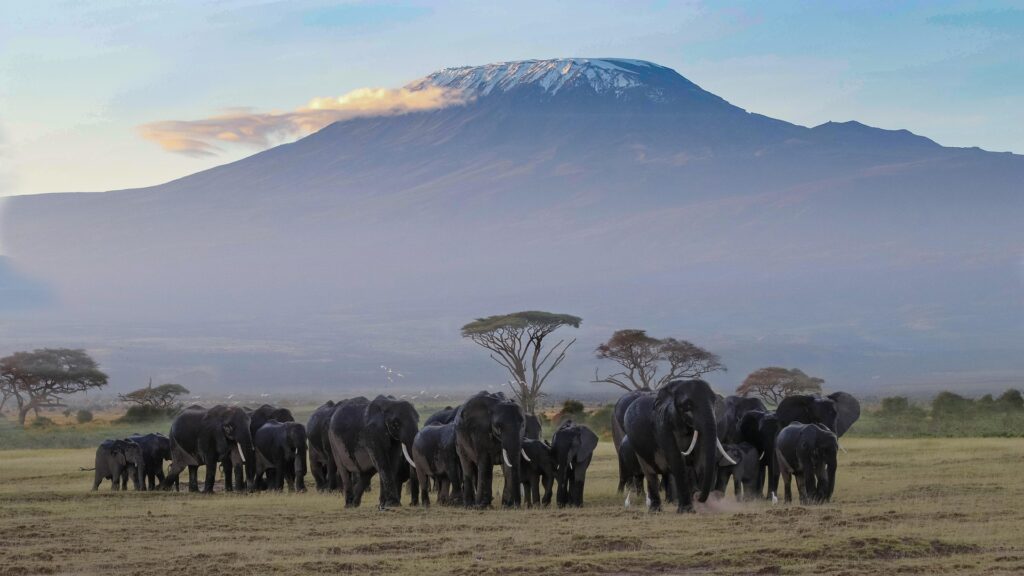If you love wildlife, stunning landscapes, and epic safari adventures, Amboseli National Park is a place you need to know about. It is located in Kenya, on the southern side of the country, on its border with Tanzania. The park is famous for its concentration of elephant herds and unreal views of Mount Kilimanjaro. But there’s more to this park than just elephants and postcard-perfect scenery! Here are some incredible Amboseli National Park facts that make it one of Africa’s most extraordinary safari destinations:
Amboseli National Park facts
Best views of Kilimanjaro
One of the obvious Amboseli National Park facts is that it’s one of the most scenic safari destinations in Africa. Endless golden savannahs stretching as far as the eye can see, dotted with acacia trees, shimmering swamps, and dry lake beds that create an otherworldly landscape are just but a taste of the scenic views. During sunrise and sunset, the park literally glows in pink and orange shades, making it a dream for photographers and nature lovers alike.
However, even with all these amazing views, nothing comes close to the views of Mount Kilimanjaro! Towering at 5,895 meters (19,341 feet), Africa’s highest peak provides a jaw-dropping backdrop to Amboseli’s already stunning scenery.

On a clear morning, the snow-capped summit appears almost surreal, rising above the clouds and watching over the park like a silent guardian. This view is especially magical when elephants, giraffes, and zebras roam the open plains beneath it, creating a picture-perfect African safari scene. I mean, there are photographers who come all the way to Amboseli just to take a photo of this specific scene. Again, it’s unreal!
A surprisingly diverse ecosystem
At first glance, Amboseli might seem like a vast dry savannah, but if you take a closer look, you’ll discover just how diverse the ecosystem really is. Despite its relatively small size, the park packs in grasslands, woodlands, swamps, and even a seasonal lake, which creates a unique mix of habitats that support a wide range of wildlife.

One of the most fascinating features is the permanent swamps that are fed by underground streams from Mount Kilimanjaro melting glaciers. These lush wetlands provide a year-round water source, which attracts the hippos, elephants and countless bird species. The contrast between the swamp’s greenery and the surrounding dry, dusty plains makes for an incredible sight – and a rare phenomenon in Kenya’s national parks.
Then there’s Lake Amboseli, a vast dry lakebed that only fills up during heavy rains. Most of the time, it’s a stark, open expanse where dust devils dance across the cracked earth, creating a dramatic, almost otherworldly landscape.

But when the rains come, the lake comes to life, attracting flamingos and other water birds in an incredible transformation. So, without a doubt, this blend of wet and dry habitats is one of the most incredible Amboseli National Park facts, as there is no other place like it in Kenya.
One of the oldest national parks in Kenya
Amboseli was established as a game reserve in 1906, referred to as the Maasai Amboseli Game Reserve. It later became a national park in 1974, making it one of the oldest and most iconic protected areas in Kenya.
The main reason why Amboseli was given national park status, was that by the 1970s, the park had become a crucial wildlife refuge, especially for elephants, which were facing severe threats from poaching and habitat loss. So the government had to ensure the park received better legal protection.
The elephant population in Amboseli was one of the most studied in Africa, and thanks to conservation efforts, it remains home to some of the largest and oldest tuskers today.
Amboseli is home to most long-tusked elephants
As we previously stated, Amboseli is home to the highest concentration of elephants in Africa. It is also home to some of the largest and longest-tasked elephants in Africa. It’s due to its strong conservation efforts you will find so many long tuskers in the Amboseli.
Unlike in many other places where poaching has reduced the number of elephants with large tusks, Amboseli’s elephants have been studied and protected for decades, allowing them to grow to old age – and with age comes massive tusks.

One of the most legendary tuskers in Amboseli is Tim, a gentle giant who became an icon before passing away in 2020. His tusks were so long they nearly touched the ground! The Amboseli Elephant Research Project (AERP), one of the world’s longest-running elephant studies, has been instrumental in protecting these giants.
The constant presence of researchers, tourists, game wardens, and the Maasai people has helped drastically reduce the chances of poaching in this park.
Amboseli’s Elephants Can “Talk” Through the Ground
This one is interesting! Did you know elephants can ‘talk’ to each other? Well, this is according to research conducted in Amboseli National Park, which revealed that elephants use low-frequency (infrasound) that travel through the earth as seismic vibrations. These signals can be detected by other elephants miles away, allowing them to communicate even when they are out of sight. This research was done by researchers from Save the Elephants and ElephantVoices.

Scientists noticed that elephants often seemed to react to distant threats or calls before they could be seen or heard. This led researchers to suspect that elephants might be using another method of communication – possibly through the ground.
So, they decided to test for seismic sensitivity using some specialized recording devices buried in the ground and then observed how nearby elephants reacted. While this entire study was done in the Amboseli, scientists are looking to understand whether this discovery is unique to this park only.
A UNESCO World Heritage site
Another Amboseli National Park fact that makes this destination special is its status as a UNESCO Biosphere Reserve, designated in 1991. This recognition highlights Amboseli’s ecological importance, not just for Kenya but for the entire world.
As a UNESCO site, Amboseli is protected for its unique ecosystem, which supports a vast range of wildlife, including its famous elephants, lions, cheetahs, and over 400 bird species. In addition, the park’s seasonal swamps, open plains, and dry lakebeds create a rare mix of habitats, allowing diverse species to thrive.
The size of Amboseli National park
Today, the Amboseli National Park is about 392 square kilometres (151 square miles). However, it wasn’t always this size! When it was first established as a game reserve in 1906, it covered a vast area of 8100 square kilometres (3100 square miles) – more than 20 times larger than its size today.
But when it was officially designated a national park in 1974, its size was drastically reduced to return much of the land to the local Maasai people who had lived in the land for generations. Instead of being completely absorbed into the park, the surrounding land was set aside as Maasai communal territory, allowing them to continue their traditional way of life while coexisting with wildlife.
Conclusion
Amboseli National Park is often considered the second most popular national park in Kenya, right after the Maasai Mara National Reserve.
One of the major Amboseli National Park facts that contribute to its popularity is its incredible elephant population – it’s one of the best places in Africa to see large herds of elephants up close. The park’s stunning views of Mount Kilimanjaro, diverse wildlife, and unique ecosystem also make it a top destination for both tourists and photographers.
Unlike the Maasai Mara, which is famous for the Great Migration, Amboseli stands out for its year-round wildlife viewing, thanks to its permanent swamps that attract animals even during dry seasons. Its compact size also makes game viewing easier since wildlife is more concentrated compared to larger parks.
With that said, Amboseli continues to be a favourite among visitors, cementing its place as a top safari destination, not just in Kenya, but in the entire African continent.

